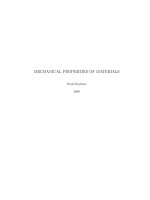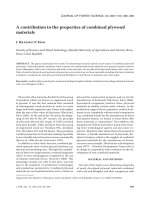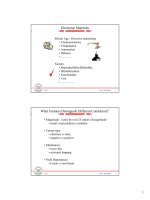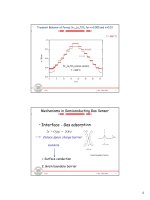Electronic properties of materials rolf e hummel
Bạn đang xem bản rút gọn của tài liệu. Xem và tải ngay bản đầy đủ của tài liệu tại đây (5.4 MB, 508 trang )
Electronic Properties of Materials
Fourth Edition
Rolf E. Hummel
Electronic Properties
of Materials
Fourth Edition
Rolf E. Hummel
College of Engineering
University of Florida
Rhines Hall 216
Gainesville, FL 32611, USA
ISBN 978-1-4419-8163-9
e-ISBN 978-1-4419-8164-6
DOI 10.1007/978-1-4419-8164-6
Springer New York Dordrecht Heidelberg London
Library of Congress Control Number: 2011921720
# Springer ScienceỵBusiness Media, LLC 2011, 2001, 1993, 1985
All rights reserved. This work may not be translated or copied in whole or in part without the written
permission of the publisher (Springer Science+Business Media, LLC, 233 Spring Street, New York, NY
10013, USA), except for brief excerpts in connection with reviews or scholarly analysis. Use in
connection with any form of information storage and retrieval, electronic adaptation, computer
software, or by similar or dissimilar methodology now known or hereafter developed is forbidden.
The use in this publication of trade names, trademarks, service marks, and similar terms, even if they are
not identified as such, is not to be taken as an expression of opinion as to whether or not they are subject
to proprietary rights.
Printed on acid-free paper
Springer is part of Springer Science+Business Media (www.springer.com)
Preface to the Fourth Edition
The present textbook, which introduces my readers to elements of solid state
physics and then moves on to the presentation of electrical, optical, magnetic, and thermal properties of materials, has been in print for 25 years, i.e.
since 1985 when the first edition appeared. It has received quite favorable
acceptance by students, professors, and scientists who particularly appreciated that the text is easy to understand and that it emphasizes concepts
rather than overburdening the reader with mathematical formalism. I am
grateful for all the kind comments which reached me either by personal
letters or in reviews found in scientific journals and on the internet.
The third edition was published in 2001, and was followed by a revised
printing in 2005. My publisher therefore felt that a new edition would be in
order at this time to give me the opportunity to update the material in a field
which undergoes explosive development. I do this update with some reluctance because each new edition increases the size (and unfortunately also
the price) of a book. It is not my goal to present an encyclopedia on the
electronic properties of materials. I still feel that the book should contain
just the right amount of material that can be conveniently covered in a
15-week/3-credit hour course. Thus, the added material was restricted to the
newest developments in the field. This implies that the fundamentals,
particularly in Part I and at the beginning of Parts II to V, remained
essentially untouched. However, new topics have been added in the “applied
sections”, such as energy-saving light sources, particularly compact fluorescence light fixtures, organic light-emitting diodes (OLEDs), organic photovoltaics (OPV cells), optical fibers, pyroelectricity, phase-change memories,
blue-ray disks, holographic versatile disks, galvanoelectric phenomena
(emphasizing the entire spectrum of primary and rechargeable batteries),
graphene, quantum Hall effect, iron-based semiconductors (pnictides), etc.,
v
vi
Preface to the Fourth Edition
to mention just a few subjects. The reader should find them interesting and
educational.
As usual, a book of this wide variety of topics needs the advice of a number
of colleagues. I am grateful for the help of Drs. Paul Holloway, Wolfgang
Sigmund, Jiangeng Xue, Franky So, Jacob Jones, Thierry Dubroca, all of the
University of Florida, Dr. Markus Rettenmayr (Friedrich-Schiller-Universit€at
Jena, Germany), and to Grif Wise.
Gainesville, Florida
September 2010
Rolf E. Hummel
Preface to the Third Edition
Books are seldom finished. At best, they are abandoned. The second edition
of “Electronic Properties of Materials” has been in use now for about seven
years. During this time my publisher gave me ample opportunities to update
and improve the text whenever the book was reprinted. There were about six
of these reprinting cycles. Eventually, however, it became clear that substantially more new material had to be added to account for the stormy
developments which occurred in the field of electrical, optical, and magnetic
materials. In particular, expanded sections on flat-panel displays (liquid
crystals, electroluminescence devices, field emission displays, and plasma
displays) were added. Further, the recent developments in blue- and greenemitting LED’s and in photonics are included. Magnetic storage devices
also underwent rapid development. Thus, magneto-optical memories,
magneto-resistance devices, and new magnetic materials needed to be
covered. The sections on dielectric properties, ferroelectricity, piezoelectricity, electrostriction, and thermoelectric properties have been expanded.
Of course, the entire text was critically reviewed, updated, and improved.
However, the most extensive change I undertook was the conversion of all
equations to SI-units throughout. In most of the world and in virtually all of
the international scientific journals use of this system of units is required. If
today’s students do not learn to utilize it, another generation is “lost” on this
matter. In other words, it is important that students become comfortable with
SI units.
If plagiarism is the highest form of flattery, then I have indeed been
flattered. Substantial portions of the first edition have made up verbatim
most of another text by a professor in Madras without giving credit to where
it first appeared. In addition, pirated copies of the first and second editions
have surfaced in Asian countries. Further, a translation into Korean
vii
viii
Preface to the Third Edition
appeared. Of course, I feel that one should respect the rights of the owner of
intellectual property.
I am grateful for the many favorable comments and suggestions promulgated by professors and students from the University of Florida and other
schools who helped to improve the text. Dr. H. R€
ufer from Wacker Siltronic
AG has again appraised me of many recent developments in wafer fabrication. Professor John Reynolds (University of Florida) educated me on
the current trends in conducting polymers. Drs. Regina and Gerd M€
uller
(Agilent Corporation) enlightened me on recent LED developments.
Professor Paul Holloway (University of Florida) shared with me some
insights in phosphors and flat-panel displays. Professor Volkmar Gerold
(MPI Stuttgart) was always available when help was needed. My thanks go
to all of them.
Gainesville, Florida
October 2000
Rolf E. Hummel
Preface to the Second Edition
It is quite satisfying for an author to learn that his brainchild has been
favorably accepted by students as well as by professors and thus seems to
serve some useful purpose. This horizontally integrated text on the electronic properties of metals, alloys, semiconductors, insulators, ceramics, and
polymeric materials has been adopted by many universities in the United
States as well as abroad, probably because of the relative ease with which
the material can be understood. The book has now gone through several
reprinting cycles (among them a few pirate prints in Asian countries). I am
grateful to all readers for their acceptance and for the many encouraging
comments which have been received.
I have thought very carefully about possible changes for the second
edition. There is, of course, always room for improvement. Thus, some
rewording, deletions, and additions have been made here and there. I withstood, however, the temptation to expand considerably the book by adding
completely new subjects. Nevertheless, a few pages on recent developments
needed to be inserted. Among them are, naturally, the discussion of ceramic
(high-temperature) superconductors, and certain elements of the rapidly
expanding field of optoelectronics. Further, I felt that the readers might be
interested in learning some more practical applications which result from
the physical concepts which have been treated here. Thus, the second edition
describes common types of field-effect transistors (such as JFET, MOSFET,
and MESFET), quantum semiconductor devices, electrical memories (such
as D-RAM, S-RAM, and electrically erasable-programmable read-only
memories), and logic circuits for computers. The reader will also find an
expansion of the chapter on semiconductor device fabrication. The principal
mechanisms behind some consumer devices, such as xerography, compact
disc players, and optical computers, are also discussed.
ix
x
Preface to the Second Edition
Part III (Magnetic Properties of Materials) has been expanded to include
more details on magnetic domains, as well as magnetostriction, amorphous
ferromagnetics, the newest developments in permanent magnets, new magnetic recording materials, and magneto-optical memories.
Whenever appropriate, some economic facts pertaining to the manufacturing processes or sales figures have been given. Responding to occasional requests, the solutions for the numerical problems are now contained
in the Appendix.
I am grateful for valuable expert advice from a number of colleagues,
such as Professor Volkmar Gerold, Dr. Dieter Hagmann, Dr. H. R€
ufer,
Mr. David Malone, Professor Chris Batich, Professor Rolf Haase,
Professor Robert Park, Professor Rajiv Singh, and Professor Ken Watson.
Mrs. Angelika Hagmann and, to a lesser extent, my daughter, Sirka Hummel,
have drawn the new figures. I thank them for their patience.
Gainesville, Florida
1993
Rolf E. Hummel
Preface to the First Edition
Die meisten Grundideen der
Wissenschaft sind an sich einfach
und lassen sich in der Regel
in einer f€
ur jedermann
verst€
andlichen Sprache
wiedergeben.
—ALBERT EINSTEIN
The present book on electrical, optical, magnetic, and thermal properties of
materials is, in many aspects, different from other introductory texts in solid
state physics. First of all, this book is written for engineers, particularly
materials and electrical engineers who want to gain a fundamental understanding of semiconductor devices, magnetic materials, lasers, alloys, etc.
Second, it stresses concepts rather than mathematical formalism, which
should make the presentation relatively easy to understand. Thus, this
book provides a thorough preparation for advanced texts, monographs, or
specialized journal articles. Third, this book is not an encyclopedia. The
selection of topics is restricted to material which is considered to be
essential and which can be covered in a 15-week semester course. For
those professors who want to teach a two-semester course, supplemental
topics can be found which deepen the understanding. (These sections are
marked by an asterisk [*].) Fourth, the present text leaves the teaching of
crystallography, X-ray diffraction, diffusion, lattice defects, etc., to those
courses which specialize in these subjects. As a rule, engineering students
learn this material at the beginning of their upper division curriculum. The
reader is, however, reminded of some of these topics whenever the need
arises. Fifth, this book is distinctly divided into five self-contained parts
which may be read independently. All are based on the first part, entitled
“Fundamentals of Electron Theory”, because the electron theory of materials is a basic tool with which most material properties can be understood.
The modern electron theory of solids is relatively involved. It is, however,
not my intent to train a student to become proficient in the entire field of
quantum theory. This should be left to more specialized texts. Instead, the
essential quantum mechanical concepts are introduced only to the extent to
which they are needed for the understanding of materials science. Sixth,
xi
xii
Preface to the First Edition
plenty of practical applications are presented in the text, as well as in the
problem sections, so that the students may gain an understanding of many
devices that are used every day. In other words, I tried to bridge the gap
between physics and engineering. Finally, I gave the treatment of the optical
properties of materials about equal coverage to that of the electrical properties. This is partly due to my personal inclinations and partly because it is
felt that a more detailed description of the optical properties is needed since
most other texts on solid state physics devote relatively little space to this
topic. It should be kept in mind that the optical properties have gained an
increasing amount of attention in recent years, because of their potential
application in communication devices as well as their contributions to the
understanding of the electronic structure of materials.
The philosophy and substance of the present text emerged from lecture
notes which I accumulated during more than twenty years of teaching.
A preliminary version of Parts I and II appeared several years ago in Journal
of Educational Modules for Materials Science and Engineering 4, 1 (1982)
and 4, 781 (1982).
I sincerely hope that students who read and work with this book will
enjoy, as much as I, the journey through the fascinating field of the physical
properties of materials.
Each work benefits greatly from the interaction between author and
colleagues or students. I am grateful in particular to Professor R.T. DeHoff,
who read the entire manuscript and who helped with his inquisitive mind to
clarify many points in the presentation. Professor Ken Watson read the part
dealing with magnetism and made many helpful suggestions. Other colleagues to whom I am indebted are Professor Fred Lindholm, Professor Terry
Orlando, and Dr. Siegfried Hofmann. My daughter, Sirka Hummel, contributed with her skills as an artist. Last, but not least, I am obliged to my
family, to faculty, and to the chairman of the Department of Materials
Science and Engineering at the University of Florida for providing the
harmonious atmosphere which is of the utmost necessity for being creative.
Gainesville, Florida
1985
Rolf E. Hummel
Contents
Preface to the Fourth Edition
Preface to the Third Edition
Preface to the Second Edition
Preface to the First Edition
v
vii
ix
xi
PART I
Fundamentals of Electron Theory
CHAPTER 1
Introduction
CHAPTER 2
The Wave-Particle Duality
Problems
CHAPTER 3
The Schr€odinger Equation
3.1. The Time-Independent Schr€
odinger Equation
*3.2. The Time-Dependent Schr€
odinger Equation
*3.3. Special Properties of Vibrational Problems
Problems
CHAPTER 4
Solution of the Schr€
odinger Equation for Four Specific Problems
4.1. Free Electrons
4.2. Electron in a Potential Well (Bound Electron)
3
7
14
15
15
16
17
18
19
19
21
xiii
xiv
4.3. Finite Potential Barrier (Tunnel Effect)
4.4. Electron in a Periodic Field of a Crystal (The Solid State)
Problems
CHAPTER 5
Energy Bands in Crystals
5.1. One-Dimensional Zone Schemes
5.2. One- and Two-Dimensional Brillouin Zones
*5.3. Three-Dimensional Brillouin Zones
*5.4. Wigner–Seitz Cells
*5.5. Translation Vectors and the Reciprocal Lattice
*5.6. Free Electron Bands
5.7. Band Structures for Some Metals and Semiconductors
5.8. Curves and Planes of Equal Energy
Problems
CHAPTER 6
Electrons in a Crystal
6.1. Fermi Energy and Fermi Surface
6.2. Fermi Distribution Function
6.3. Density of States
6.4. Complete Density of States Function Within a Band
6.5. Population Density
6.6. Consequences of the Band Model
6.7. Effective Mass
6.8. Conclusion
Problems
Suggestions for Further Reading (Part I)
Contents
25
29
36
37
37
42
45
46
48
52
56
59
61
63
63
64
65
67
68
70
71
74
74
75
PART II
Electrical Properties of Materials
CHAPTER 7
Electrical Conduction in Metals and Alloys
7.1.
7.2.
7.3.
7.4.
7.5.
Introduction
Survey
Conductivity—Classical Electron Theory
Conductivity—Quantum Mechanical Considerations
Experimental Results and Their Interpretation
7.5.1. Pure Metals
7.5.2. Alloys
7.5.3. Ordering
7.6. Superconductivity
7.6.1. Experimental Results
*7.6.2. Theory
79
79
80
82
85
89
89
90
92
93
95
100
Contents
7.7. Thermoelectric Phenomena
7.8. Galvanoelectric Phenomena (Batteries)
7.8.1. Primary Cells
7.8.2. Secondary Cells
7.8.3. Closing Remarks
Problems
CHAPTER 8
Semiconductors
8.1. Band Structure
8.2. Intrinsic Semiconductors
8.3. Extrinsic Semiconductors
8.3.1. Donors and Acceptors
8.3.2. Band Structure
8.3.3. Temperature Dependence of the Number of Carriers
8.3.4. Conductivity
8.3.5. Fermi Energy
*8.4. Effective Mass
8.5. Hall Effect
8.6. Compound Semiconductors
8.7. Semiconductor Devices
8.7.1. Metal–Semiconductor Contacts
8.7.2. Rectifying Contacts (Schottky Barrier Contacts)
8.7.3. Ohmic Contacts (Metallizations)
8.7.4. p–n Rectifier (Diode)
8.7.5. Zener Diode
8.7.6. Solar Cell (Photodiode)
*8.7.7. Avalanche Photodiode
*8.7.8. Tunnel Diode
8.7.9. Transistors
*8.7.10. Quantum Semiconductor Devices
8.7.11. Semiconductor Device Fabrication
*8.7.12. Digital Circuits and Memory Devices
Problems
CHAPTER 9
Electrical Properties of Polymers, Ceramics, Dielectrics,
and Amorphous Materials
9.1.
9.2.
9.3.
9.4.
Conducting Polymers and Organic Metals
Ionic Conduction
Conduction in Metal Oxides
Amorphous Materials (Metallic Glasses)
9.4.1. Xerography
9.5. Dielectric Properties
9.6. Ferroelectricity, Piezoelectricity, Electrostriction, and Pyroelectricity
Problems
Suggestions for Further Reading (Part II)
xv
103
105
105
108
112
113
115
115
117
122
122
123
124
125
126
127
127
129
131
131
132
136
137
140
141
145
145
147
156
159
168
177
181
181
191
194
196
200
202
206
210
210
xvi
Contents
PART III
Optical Properties of Materials
CHAPTER 10
The Optical Constants
10.1. Introduction
10.2. Index of Refraction, n
10.3. Damping Constant, k
10.4. Characteristic Penetration Depth, W, and Absorbance, a
10.5. Reflectivity, R, and Transmittance, T
10.6. Hagen–Rubens Relation
Problems
CHAPTER 11
Atomistic Theory of the Optical Properties
11.1.
11.2.
11.3.
11.4.
11.5.
11.6.
*11.7.
Survey
Free Electrons Without Damping
Free Electrons With Damping (Classical Free Electron Theory of Metals)
Special Cases
Reflectivity
Bound Electrons (Classical Electron Theory of Dielectric Materials)
Discussion of the Lorentz Equations for Special Cases
11.7.1. High Frequencies
11.7.2. Small Damping
11.7.3. Absorption Near n0
11.7.4. More Than One Oscillator
11.8. Contributions of Free Electrons and Harmonic Oscillators
to the Optical Constants
Problems
CHAPTER 12
Quantum Mechanical Treatment of the Optical Properties
12.1. Introduction
12.2. Absorption of Light by Interband and Intraband Transitions
12.3. Optical Spectra of Materials
*12.4. Dispersion
Problems
CHAPTER 13
Applications
13.1. Measurement of the Optical Properties
*13.1.1. Kramers–Kronig Analysis (Dispersion Relations)
*13.1.2. Spectroscopic Ellipsometry
*13.1.3. Differential Reflectometry
13.2. Optical Spectra of Pure Metals
13.2.1. Reflection Spectra
*13.2.2. Plasma Oscillations
215
215
217
218
222
223
225
225
227
227
230
233
236
237
238
242
242
242
243
243
244
245
247
247
247
251
251
256
259
259
260
260
263
266
266
270
Contents
xvii
13.3.
*13.4.
*13.5.
13.6.
13.7.
13.8.
271
275
277
278
281
284
284
288
291
292
293
295
296
297
298
299
300
301
302
305
308
310
312
315
315
317
319
320
322
323
324
325
329
332
334
335
Optical Spectra of Alloys
Ordering
Corrosion
Semiconductors
Insulators (Dielectric Materials and Glass Fibers)
Emission of Light
13.8.1. Spontaneous Emission
13.8.2. Stimulated Emission (Lasers)
13.8.3. Helium–Neon Laser
13.8.4. Carbon Dioxide Laser
13.8.5. Semiconductor Laser
13.8.6. Direct–Versus Indirect–Band Gap Semiconductor Lasers
13.8.7. Wavelength of Emitted Light
13.8.8. Threshold Current Density
13.8.9. Homojunction Versus Heterojunction Lasers
13.8.10. Laser Modulation
13.8.11. Laser Amplifier
13.8.12. Quantum Well Lasers
13.8.13. Light-Emitting Diodes (LED)
13.8.14. Organic Light Emitting Diodes (OLEDs)
13.8.15. Organic Photovoltaic Cells (OPVCs)
13.8.16. Liquid Crystal Displays (LCDs)
13.8.17. Emissive Flat-Panel Displays
13.9. Integrated Optoelectronics
13.9.1. Passive Waveguides
13.9.2. Electro-Optical Waveguides (EOW)
13.9.3. Optical Modulators and Switches
13.9.4. Coupling and Device Integration
13.9.5. Energy Losses
13.9.6. Photonics
13.9.7. Optical Fibers
13.10. Optical Storage Devices
13.11. The Optical Computer
13.12. X-Ray Emission
Problems
Suggestions for Further Reading (Part III)
PART IV
Magnetic Properties of Materials
CHAPTER 14
Foundations of Magnetism
14.1. Introduction
14.2. Basic Concepts in Magnetism
*14.3. Units
Problems
339
339
340
344
345
xviii
Contents
CHAPTER 15
Magnetic Phenomena and Their Interpretation—Classical Approach
15.1. Overview
15.1.1. Diamagnetism
15.1.2. Paramagnetism
15.1.3. Ferromagnetism
15.1.4. Antiferromagnetism
15.1.5. Ferrimagnetism
15.2. Langevin Theory of Diamagnetism
*15.3. Langevin Theory of (Electron Orbit) Paramagnetism
*15.4. Molecular Field Theory
Problems
CHAPTER 16
Quantum Mechanical Considerations
16.1. Paramagnetism and Diamagnetism
16.2. Ferromagnetism and Antiferromagnetism
Problems
CHAPTER 17
Applications
17.1. Introduction
17.2. Electrical Steels (Soft Magnetic Materials)
17.2.1. Core Losses
17.2.2. Grain Orientation
17.2.3. Composition of Core Materials
17.2.4. Amorphous Ferromagnets
17.3. Permanent Magnets (Hard Magnetic Materials)
17.4. Magnetic Recording and Magnetic Memories
17.4.1. Closing Remarks
Problems
Suggestions for Further Reading (Part IV)
347
347
347
349
352
358
359
362
364
368
371
373
373
378
382
385
385
385
386
388
390
390
391
394
400
400
400
PART V
Thermal Properties of Materials
CHAPTER 18
Introduction
CHAPTER 19
Fundamentals of Thermal Properties
19.1.
19.2.
19.3.
19.4.
Heat, Work, and Energy
Heat Capacity, C0
Specific Heat Capacity, c
Molar Heat Capacity, Cv
405
409
409
410
411
412
Contents
xix
19.5. Thermal Conductivity, K
19.6. The Ideal Gas Equation
19.7. Kinetic Energy of Gases
Problems
413
414
415
416
CHAPTER 20
Heat Capacity
20.1. Classical (Atomistic) Theory of Heat Capacity
20.2. Quantum Mechanical Considerations—The Phonon
20.2.1. Einstein Model
20.2.2. Debye Model
20.3. Electronic Contribution to the Heat Capacity
Problems
CHAPTER 21
Thermal Conduction
21.1. Thermal Conduction in Metals and Alloys—Classical Approach
21.2. Thermal Conduction in Metals and Alloys—Quantum
Mechanical Considerations
21.3. Thermal Conduction in Dielectric Materials
Problems
CHAPTER 22
Thermal Expansion
Problems
Suggestions for Further Reading (Part V)
Appendices
App. 1.
App. 2.
App. 3.
App. 4.
App. 5.
Periodic Disturbances
Euler Equations
Summary of Quantum Number Characteristics
Tables
About Solving Problems and Solutions to Problems
419
419
421
421
424
426
429
431
432
434
435
437
439
441
441
443
445
450
451
454
467
About the Author
473
Index
475
Note: Sections marked with an asterisk (*) are topics which are beyond a 15-week semester
course or may be treated in a graduate course.
.
PART I
FUNDAMENTALS OF
ELECTRON THEORY
.
CHAPTER 1
Introduction
The understanding of the behavior of electrons in solids is one of the keys
to understanding materials. The electron theory of solids is capable of
explaining the optical, magnetic, thermal, as well as the electrical properties
of materials. In other words, the electron theory provides important fundamentals for a technology which is often considered to be the basis for
modern civilization. A few examples will illustrate this. Magnetic materials
are used in electric generators, motors, loudspeakers, transformers, tape
recorders, and tapes. Optical properties of materials are utilized in lasers,
optical communication, windows, lenses, optical coatings, solar collectors,
and reflectors. Thermal properties play a role in refrigeration and heating
devices and in heat shields for spacecraft. Some materials are extremely
good electrical conductors, such as silver and copper; others are good
insulators, such as porcelain or quartz. Semiconductors are generally poor
conductors at room temperature. However, if traces of certain elements are
added, the electrical conductivity increases.
Since the invention of the transistor in the late 1940s, the electronics
industry has grown to an annual sales level of about five trillion dollars.
From the very beginning, materials and materials research have been the
lifeblood of the electronics industry.
For the understanding of the electronic properties of materials, three
approaches have been developed during the past hundred years or so which
differ considerably in their philosophy and their level of sophistication. In the
nineteenth century, a phenomenological description of the experimental
observation was widely used. The laws which were eventually discovered
were empirically derived. This “continuum theory” considered only macroscopic quantities and interrelated experimental data. No assumptions were
made about the structure of matter when the equations were formulated. The
R.E. Hummel, Electronic Properties of Materials 4th edition,
DOI 10.1007/978-1-4419-8164-6_1, # Springer ScienceỵBusiness Media, LLC 2011
3
4
I. Fundamentals of Electron Theory
conclusions that can be drawn from the empirical laws still have validity, at
least as long as no oversimplifications are made during their interpretation.
Ohm’s law, the Maxwell equations, Newton’s law, and the Hagen–Rubens
equation may serve as examples.
A refinement in understanding the properties of materials was accomplished at the turn to the twentieth century by introducing atomistic
principles into the description of matter. The “classical electron theory”
postulated that free electrons in metals drift as a response to an external
force and interact with certain lattice atoms. Paul Drude was the principal
proponent of this approach. He developed several fundamental equations
that are still widely utilized today. We will make extensive use of the
Drude equations in subsequent parts of this book.
A further refinement was accomplished at the beginning of the twentieth
century by quantum theory. This approach was able to explain important
experimental observations which could not be readily interpreted by classical means. It was realized that Newtonian mechanics become inaccurate
when they are applied to systems with atomic dimensions, i.e., when
attempts are made to explain the interactions of electrons with solids.
Quantum theory, however, lacks vivid visualization of the phenomena
which it describes. Thus, a considerable effort needs to be undertaken to
comprehend its basic concepts; but mastering its principles leads to a much
deeper understanding of the electronic properties of materials.
The first part of the present book introduces the reader to the fundamentals of quantum theory. Upon completion of this part the reader should
be comfortable with terms such as Fermi energy, density of states, Fermi
distribution function, band structure, Brillouin zones, effective mass of
electrons, uncertainty principle, and quantization of energy levels. These
concepts will be needed in the following parts of the book.
It is assumed that the reader has taken courses in freshman physics,
chemistry, and differential equations. From these courses the reader should
be familiar with the necessary mathematics and relevant equations and
definitions, such as:
Newton’s law: force equals mass times acceleration (F ẳ maị;
Kinetic energy: Ekin ẳ 12 mv2 v is the particle velocityị;
Momentum: p ẳ mv;
p2
;
Combining (1.2) and (1.3) yields Ekin ¼
2m
Speed of light: c ¼ nl ðn ¼ frequency of the light wave, and
l its wavelengthÞ;
Velocity of a wave: v ¼ nl;
Angular frequency: o ¼ 2pn;
Einstein’s mass---energy equivalence: E ¼ mc2 :
(1.1)
(1.2)
(1.3)
(1.4)
(1.5)
(1.6)
(1.7)
(1.8)
1. Introduction
5
It would be further helpful if the reader has taken an introductory course
in materials science or a course in crystallography in order to be familiar
with terms such as lattice constant, Miller’s indices, X-ray diffraction,
Bragg’s law, etc. Regardless, these concepts are briefly summarized in this
text whenever they are needed. In order to keep the book as self-contained as
possible, some fundamentals in mathematics and physics are summarized in
the Appendices.
![Structures and electronic properties of si nanowires grown along the [1 1 0] direction role of surface reconstruction](https://media.store123doc.com/images/document/14/rc/td/medium_tdu1394959072.jpg)








